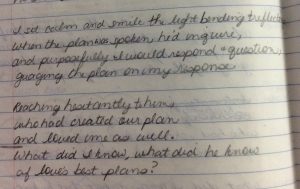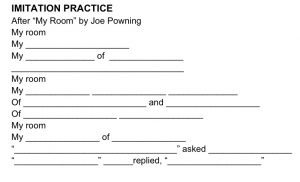Several years ago, I participated in the Oakland Writing Project. Here, I learned a strategy that enhanced my writing and my study of authors’ craft. I began to understand how writers wrote, and I learned to use those same moves in my own writing.
Last week, I spent some time in my friend’s classroom, and she was using the same strategy with her students. The strategy is imitation, and it helps student-writers to develop their voice and enhance their ability to make choices.
Walking into the room, I smiled when I saw this learning target on the board: “I can imitate a mentor poem.” I immediately thought back to the first poem I imitated in The Oakland Writing Project. It was “Those Winter Sundays,” by Robert Hayden.
This is a short poem with only three stanzas. It describes a routine morning where a dad gets up early to light fires to warm the house. There are also underlying messages like the speaker’s lack of gratitude and a fear of his father.
Through imitation, I could mimic the topic or theme of the poem, or I could imitate the structure and style of the poem. In the picture above, you can see that I imitated the structure by keeping the same number of lines and words.
Imitation in the Classroom
Learning from my own writing experiences, I teach imitation to students.
We start small and grow when students are ready. We start by using the same topic as the writer. We imitate the same number of words per line and the same number of lines in a stanza. To model for kids how to begin this work, a template might look like the one listed to the right. (Click on the image to enlarge it.)
At this point, you’ve given students something successful which they can strive to imitate, but they haven’t made any personal writing choices. As you conference with students, you’ll notice that some are ready to move forward. A great next step for student-writers is to choose a topic of his/her own within the same structure as the mentor poem. This allows the writing to begin to be the student’s.
Another next step is to study the words and imitate craft choices like alliteration and assonance, verb and noun placement, and words that share similar syllables.
Breaking Away from Imitation
In a later draft of my own poem, I used a standalone line. The poem I was imitating doesn’t have a standalone line, but as a writer, I felt that my writing needed that line, which took me out of imitation. So, I started using the strategy and continued by making decisions of my own.
Later, another writing piece became my own, even though I started with imitation. I began with “Patterns,” by Anne Atwell-McLeod. Here is a finished piece of writing that began with imitation.
You’ll notice while conferencing that, as they’re ready to move forward with imitation, some students will continue to use these strategies. They will also grow the strategies they use throughout the year as you expose them to excellent mentor texts.
 Amy Gurney (@agurney_amy) is an ELA and Social Studies Curriculum Coordinator for Walled Lake Schools. She has a Master’s degree from Michigan State University in Educational Administration and is currently pursuing an Education Specialist in Educational Leadership at Oakland University. She is a current Galileo Leader. She worked on the MAISA units of study and has studied reading and writing workshop practice and conducted action research.
Amy Gurney (@agurney_amy) is an ELA and Social Studies Curriculum Coordinator for Walled Lake Schools. She has a Master’s degree from Michigan State University in Educational Administration and is currently pursuing an Education Specialist in Educational Leadership at Oakland University. She is a current Galileo Leader. She worked on the MAISA units of study and has studied reading and writing workshop practice and conducted action research.


